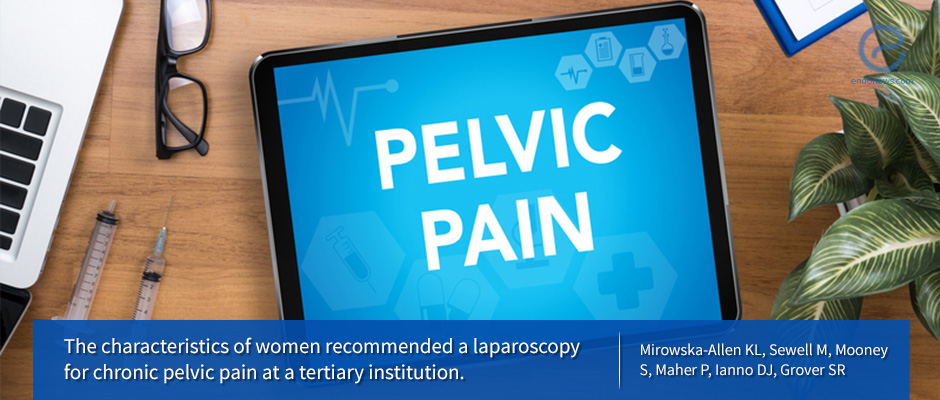Women recommended laparoscopy for chronic pelvic pain
Aug 28, 2018
Severe painful menstruation, an unsuccessful trial of hormonal therapy, previous abdominal surgery, prior pelvic laparoscopy and past diagnosis of endometriosis increase the rate of laparoscopy in women with chronic pelvic pain.
Key Points
Highlights:
- The factors increasing the rate of laparoscopy in women with chronic pelvic pain are severe painful menstruation, an unsuccessful trial of hormonal therapy, the presence of a prior abdominal surgery or pelvic laparoscopy and a past diagnosis of endometriosis.
What's done here:
- This is a prospective study with a retrospective review of medical records of women with chronic pelvic pain.
- The researchers asked the patients and gynecologists who booked patients for surgery to complete a survey which included demographic, symptomatologic, previous medical and family history information.
- Gynecologists completed a survey that inquires variables that affected their decision to operate.
Key results:
- The presentation of women booked for surgery was associated with failed hormonal treatment, severe painful menstruation, past pelvic laparoscopy, previous endometriosis, abnormal vaginal examination, adnexal tenderness to the ultrasound probe and the presence of a deep infiltrating endometriosis.
- According to gynecologists’ survey, the most common reasons for booking surgery were severity and the duration of pain and a failed trial of hormonal therapy.
Limitations:
- The study reflects the finding of a single center and the duration of follow up of patients was short.
- Since not all patients were examined, underwent ultrasound imaging and not all surveys completed by gynecologists, there may be some selection bias in the results.
- Cases are not surgically proven endometriosis, and the study did not contain any women who had moderate or severe endometriosis.
- Operative reports poorly recorded the details of adhesive disease and may have under-represented the extent of endometrial disease.
- Researchers tested each association individually and none of them corrected for multiplicity.
Lay Summary
Chronic pelvic pain is a diagnostic and therapeutic dilemma. It has many etiologies in many organ systems. Clinician and patient factors affect the management of chronic pelvic pain.
Mirowska-Allen K.L. et al. have recently published an article titled, “The characteristics of women recommended a laparoscopy for chronic pelvic pain at a tertiary institution” in the journal Australian and New Zealand Journal of Obstetrics and Gynaecology. They aimed to understand the characteristics of women offered laparoscopic pelvic surgery for chronic pelvic pain. Their other aim was to find why gynecologists chose laparoscopic surgery.
The researchers asked the patients to complete a study questionnaire about their symptoms, medical history, quality of life and pain catastrophization. Gynecologists who recommended a laparoscopy completed a survey indicating their reasons at the time of booking for surgery. Examination and ultrasound findings were collected from patient records, and the outcomes were evaluated by a Cox proportional hazards ratio (HR) model.
There were 211 participants in the study and 59(28%) underwent laparoscopic surgery. Factors increasing the rate of laparoscopy were severe painful menstruation, an unsuccessful trial of hormonal therapy, previous abdominal surgery, prior pelvic laparoscopy and past diagnosis of endometriosis. Abnormal vaginal examination and ultrasound probe tenderness also increased the probability of surgery. Family history, quality of life or pain catastrophization were not different between surgical and non-surgical patients. Gynecologists surveys revealed that operation decision was most influenced by the severity or duration of pain, but mostly not by examination or ultrasound findings.
According to the patient questionnaire, the characteristics of women booked for surgery were similar to those present in the literature. Patient characteristics in the questionnaires showed some difference from those indicated by gynecologists.
We need further well-designed studies to identify and assess proper clinical decision-making for chronic pelvic pain. The results of the current study may aid in the development of guidelines for its investigative algorithm.
Research Source: https://www.ncbi.nlm.nih.gov/pubmed/29926915
ultrasound chronic pain dysmenorrhoea endometriosis laparoscopy pelvic pain painful menstruation medical history quality of life questionnaire

